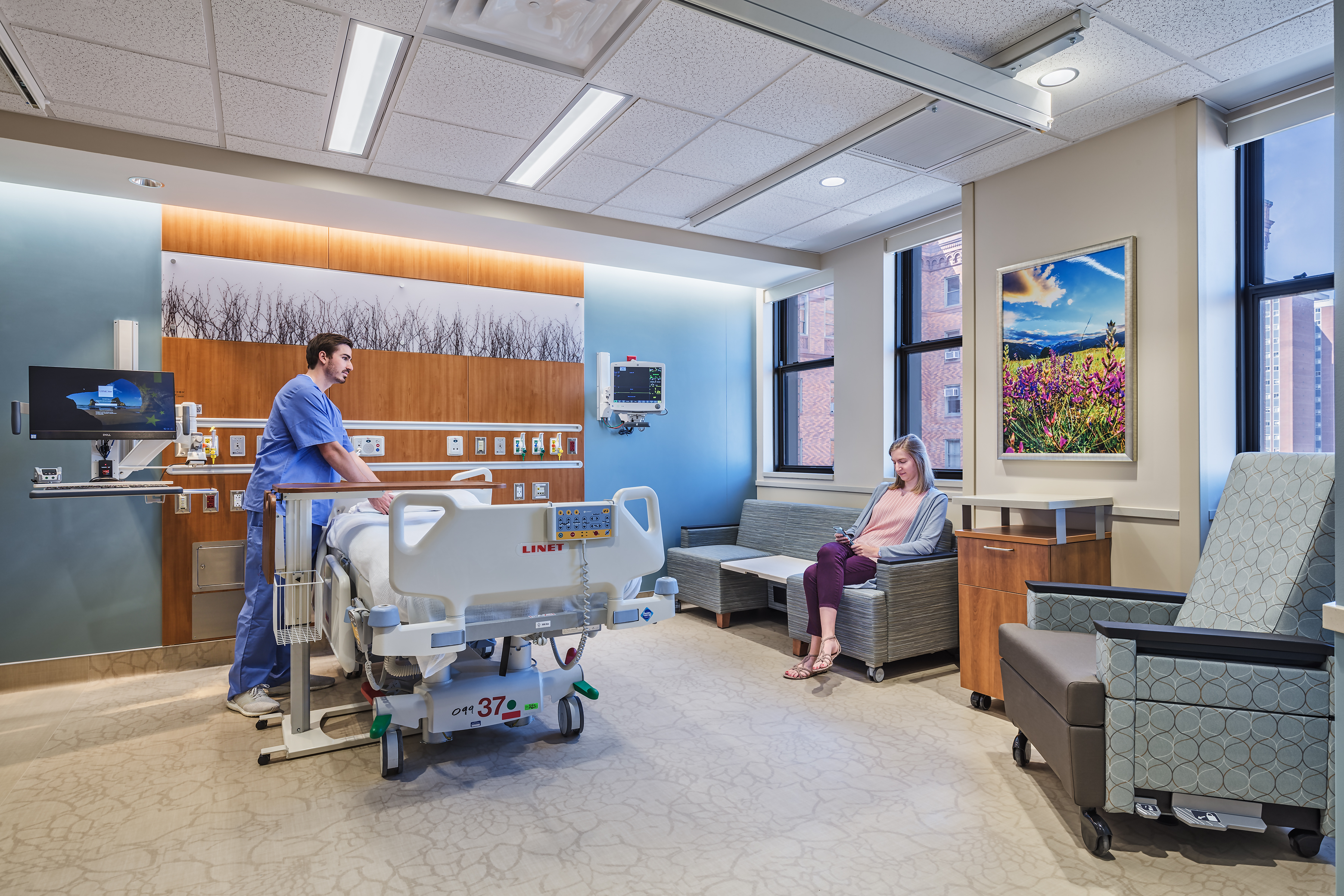Family members and caregivers are more than guests. They’re a vital part of patient healing. Here’s how to design an inpatient room that accommodates their needs, too.
By Angela Kolosky
AIA, ACHA, NCARB, LEED AP BD+C
Associate Principal, Healthcare Planning Market Leader
When designing inpatient rooms, no matter the specialty, countless details must be anticipated. Have we mitigated fall risks? Can providers easily access the patient? Are supplies and meds easily restocked and close at hand? Patient and medical staff needs are paramount.
But what about family members and caregivers? Their space in an inpatient room is often the last to be factored into a project – and with varying success. In the last few decades we’ve seen some improvement (especially with the advent of the private patient room) but many inpatient rooms still overlook the needs of loved ones caring for a family member or friend.
And that’s a shame, because these are more than visitors. They’re an important part of the healing process.
Designing a patient room that’s empathetic to these users can be broken down into two fundamental objectives: Helping caregivers as they interact with the patient, and helping as they themselves exist in the space.
Care for the patient
Having a friend and family caregiver in the room is so important for patient well being – for both psychological and physiological benefits. Sometimes referred to in research as patient guardians, caregivers not only provide companionship within the hospital setting, but can also be an advocate, provide spiritual and psychological support, ensure patient compliance, and aid in personal hygiene and toileting needs, among others (Gwaza and Msiska 2022). In a study about the impact of family presence on patients’ outcomes, it was found that both patients and healthcare providers felt that family members had a positive impact on healing, pain reduction, sleep, reducing anxiety and depression, length of stay, reducing risk of falls, and improving overall patient satisfaction (Fakhry and Mohammed 2022).
As I’ve written before, I love reflecting on my own hospital experiences to inspire design solutions. I remember caring for a loved one during their hospital stay, and how the simple act of washing her hair with her own shampoo (versus what the hospital provided) made such a difference in her demeanor. She was brighter, more alert, and engaged. While it may have been the warmth of someone caring for her, the washing away of a multi-day, bed ridden stay, or the simple aromatherapy from her favorite product (or all three!), there’s no question it improved her emotional and physical state.
As the person trying to give her a shampoo, however, I struggled to do it easily. Despite the room being a new build, I couldn’t run the water long enough to easily fill the small bucket, nor could I get it warm enough. No work surface near the patient bed meant an awkward balancing act as I tried not to soak her. While the primary function in any inpatient room is in support of clinical care, minute changes can have a strong impact on the ease of the family member and caregiver in navigating their environment. I keep these real-world needs in mind on every new project I’m a part of.

Care for themselves
Let’s be honest: a lot of time in a hospital is spent doing very little. For patients, that often means precious rest. For family members…well, it’s just waiting. And that creates challenges to their own physical and psychological comfort.
Before COVID, in an effort to give family and caregivers respite from the patient room, communal spaces were added to many patient units. Post COVID, these spaces have been under used as family members and caregivers choose to stay in the room. Not just for an infection prevention standpoint, but also for simple proximity to the patient and physicians making rounds.
Increasingly complex patient acuities require caregivers to navigate more interactions with hospital staff. An inpatient study from 2002 to 2017 found that patients are more likely to have multiple co-morbidities and medications, more likely to experience an adverse event, and are more likely to be treated for multiple acute medical issues when admitted through the emergency department (Lowry 2024). And the COVID pandemic further accelerated this shift. The result: family members and caregivers are spending even more time in the hospital setting – and experiencing higher stress.
Another real-world example: I recently spent time with a friend who was hospitalized for multiple days. I had spent the night so their partner could return home for rest. The room was designed to have a recliner at the patient headwall and a built-in (and very uncomfortable) “couch” at the footwall. When the partner returned, I offered the recliner so he could be closer to the loved one. As the patient slept, we attempted to decompress by watching TV…which was directly over my head. Nowhere in the room was there additional seating or comfort. Worse, when the rounding physician came in, it was difficult for us both to feel heard and understood. Which, of course, strained the provider in their attempt to meet the clinical needs of the patient and provide empathic communication with us.
Ideas for better room design
How can we improve these inpatient experiences? One way is to engage with family advocates to understand the nuances of the caregiver experience. Patient room design traditionally has the standard zones: for providers, patient, and family. But reality is much more complex than that. Designing flexibility into sink areas, worksurfaces, and even the patient head wall can help both the clinical team and the family member feel less confined and more at ease while providing care and support.
Modular and mobile furniture solutions have a high potential here for improving flexibility and allowing the room to be rearranged to meet varying needs throughout the day. For instance, if the patient has two visitors, the room can be arranged to allow both to sit at the head of the patient as opposed to one being relegated to the foot of the bed.
Just as clinical teams are adapting to meet more complex patient needs, so too must the patient room adapt to the needs of complex care teams that include friends and family members. By designing for flexibility and the guest’s emotional and physical needs, we can create rooms that are more adaptive and empathetic to all who spend time there.

References
Fakhry, Mohamed, and Wisam Mohammed. 2022. "Impact of family presence on healthcare outcomes." Alexandria Engineering Journal Volume 61 (Issue 12): 10713-10726. doi:https://doi.org/10.1016/j.aej.2022.04.027.
Gwaza, Elizabeth, and Gladys Msiska. 2022. "Family Involvement in Caring for Inpatients in Acute Care Hospital Settings: A Systematic Review of Literature." SAGE Open Nursing 8: 1-15. doi:10.1177/23779608221089541.
Lowry, Fran. 2024. "Hospitalized Patients Have Become More Complex Over Time." Medscape Medical News. 01 18. Accessed 04 18, 2024. https://www.medscape.com/viewarticle/hospitalized-patients-have-become-m....

Angela Kolosky, AIA, ACHA, NCARB, LEED AP BD+C | Associate Principal, Healthcare Planning Market Leader
As a Healthcare Planner, Angela uses her experience, client data, and national benchmarks to create solutions where design can create positive outcomes for patients and staff. She brings this thinking to every project and has a passion for creating impactful, positive spaces for a critical and vulnerable population. Angela is an ACHA board-certified architect and was named one of Healthcare Design’s Rising Stars in 2020. Angela speaks and writes nationally on healthcare planning topics for Healthcare Design and Healthcare Facilities Symposium and is responsible for leading healthcare planning across both of DesignGroup's offices. She’s also a founding member of the Ohio Chapter of Women in Healthcare where she advocates for the advancement of women in healthcare outside of the field of architecture.
